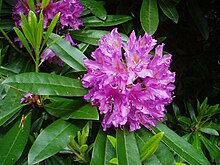
An archaeophyte is a plant species which is non-native to a geographical region, but which was an introduced species in "ancient" times, rather than being a modern introduction. Those arriving after are called neophytes.[2]
The cut-off date is usually the beginning of the early modern period (turn of the 15th or 16th century). In Britain, archaeophytes are considered to be those species first introduced prior to the year 1492, when Christopher Columbus arrived in the New World and the Columbian Exchange began.
- ^ Veröffentlichungen des Tiroler Landesmuseums Ferdinandeum - Rhododendron ponticum L. var. sebinense (SORDELLI) SORDELLI in the Late Pleistocene flora of Hötting, Northern Calcareous Alps: witness of a climate warmer than today?
- ^ Preston, Christopher D.; Pearman, David A.; Hall, Allan R. (1 July 2004). "Archaeophytes in Britain". Botanical Journal of the Linnean Society. 145 (3): 257–294. doi:10.1111/j.1095-8339.2004.00284.x. ISSN 0024-4074.